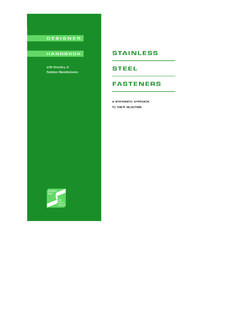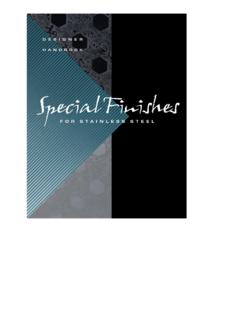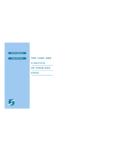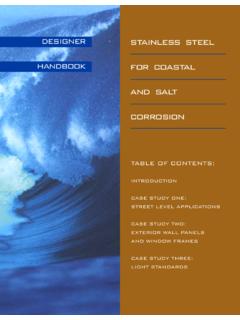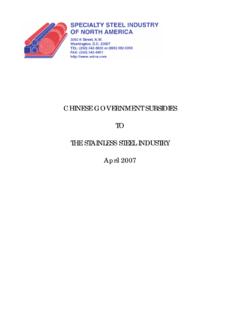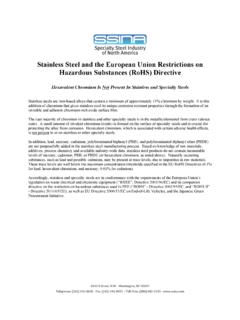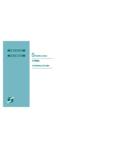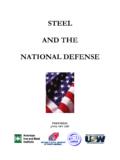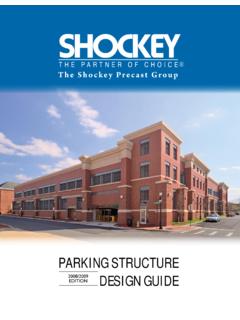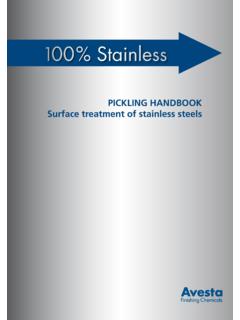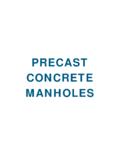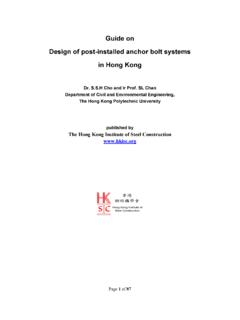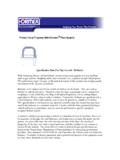Transcription of 021214 Design Guidelines - SSINA
1 021214 Design Guidelines 1/24/03 9:08 AM Page 1. 021214 Design Guidelines 1/24/03 9:08 AM Page 2. CONTENTS. lntroduction ..1. ldentification of Stainless steel ..1. Guidelines for Corrosion Material Selection ..5. Mechanical & Physical Austenitic ..9. Ferritic ..9. Martensitic ..11. Precipitation Thermal Low-Temperature Mechanical Heat Transfer Sizes, Shapes, and Fabrication ..18. Hot Forming ..18. Cold Forming ..25. Machining ..27. Fastening ..29. Surface Protection & Cleaning ..30. Appendix A. Corrosion Appendix B. Figures ..35. References ..52. The Specialty steel lndustry of North America ( SSINA ) and the individual companies it represents have made every effort to ensure that the information presented in this handbook is technically correct. However, neither the SSlNA nor its member companies warrants the accuracy of the information contained in this handbook or its suitability for any general and specific use, and assumes no liability or responsibility of any kind in connection with the use of this information.
2 The reader is advised that the material contained herein should not be used or relied on for any specific or general applications without first securing competent advice. 11-02-18. 021214 Design Guidelines 1/24/03 9:08 AM Page 1. INTRODUCTION. Stainless steels are iron-base alloys containing or more chromium. They have been used for many industrial, architectural, chemical, and consumer applications for over a half century. Currently there are being marketed a number of stainless steels originally recognized by the American lron and steel lnstitute (AISI) as standard alloys. Also commercially available are proprietary stainless steels with special characteristics. (See Appendix A.). With so many stainless steels from which to choose, designers should have a ready source of information on the characteristics and capabilities of these useful alloys. To fill this need, the Committee of Stainless steel Producers initially prepared this booklet.
3 The data was reviewed and updated by the Specialty steel lndustry of North America ( SSINA ). Written especially for Design engineers, it presents an overview of a broad range of stainless steels both standard and proprietary their compositions, their properties, their fabrication, and their use. More detailed information on the standard grades, with special emphasis on the manufacture, finish designations and dimensional and weight tolerances of the product forms in which they are marketed, is contained in the lron and steel Society of the AlME (the American lnstitute of Mining, Metallurgical and Petroleum Engineers) steel Products Manual Stainless and Heat Resisting Steels. The AlME undertook the publication, updating and sale of this manual after the AlSl discontinued publication in 1986. Reference is often made to stainless steel in the singular sense as if it were one material. Actually there are well over 100 stainless steel alloys.
4 Three general classifications are used to identify stainless steels. They are: 1. Metallurgical Structure; 2. The AlSl numbering system: namely 200, 300, and 400 Series numbers; 3. The Unified Numbering System, which was developed by American Society for Testing Materials (ASTM) and Society of Automotive Engineers (SAE). to apply to all commerical metals and alloys. There are also a number of grades known by common names that resemble AlSl designations and these are recognized by ASTM. These common names, which are neither trademarks nor closely associated with a single producer, are shown and identified in the tables. These common (non-AISI) names also appear in the ASTM. specification. Nearly all stainless steels used in North America have UNS designations. On the following pages there is a description of these classifications. Tables 1-5 list stainless steels according to metallurgical structure: austenitic, ferritic, martensitic, precipitation hardening, and duplex.
5 3050 K Street, Washington, 20007. TEL: (202) 342-8630 or (800) 982-0355. FAX: (202) 342-8631. 1. 021214 Design Guidelines 1/24/03 9:08 AM Page 2. Austenitic stainless steels (Table 1) Ferritic stainless steels (Table 2) are Precipitation-hardening stainless containing chromium and nickel are straight-chromium 400 Series types that steels (Table 4) are chromium-nickel identified as 300 Series types. Alloys cannot be hardened by heat treatment, types, some containing other alloying containing chromium, nickel and and only moderately hardened by cold elements, such as copper or aluminum. manganese are identified as 200 Series working. They are magnetic, have good They can be hardened by solution types. The stainless steels in the austenitic ductility and resistance to corrosion and treating and aging to high strength. group have different compositions and oxidation. Type 430 is the general-purpose properties, but many common character- stainless of the ferritic group.
6 Istics. They can be hardened by cold Table 4. working, but not by heat treatment. In the PRECIPITATION HARDENING. annealed condition, all are essentially Table 2 STAINLESS STEELS. nonmagnetic, although some may FERRITIC STAINLESS STEELS UNS UNS. become slightly magnetic by cold Equivalent Equivalent S13800 S17400. working. They have excellent corrosion TYPE UNS TYPE UNS S15500 S17700. resistance, unusually good formability, 405 S40500 430 FSe S43023. and increase in strength as a result of 409 S40900 434 S43400. cold work. Duplex stainless steels (Table 5) have 429 S42900 436 S43600 an annealed structure which is typically Type 304 (sometimes referred to as 430 S43000 442 S44200. 18-8 stainless) is the most widely used about equal parts of austenite and ferrite. 430F S43020 446 S44600. alloy of the austenitic group. It has a Although not formally defined, it is nominal composition of 18% chromium generally accepted that the lesser phase and 8% nickel.
7 Will be at least 30% by volume. Martensitic stainless steels (Table 3) Duplex stainless steels offer several are straight-chromium 400 Series types advantages over the common austenitic that are hardenable by heat treatment. stainless steels. The duplex grades are Table 1 They are magnetic. They resist corrosion highly resistant to chloride stress AUSTENITIC in mild environments. They have fairly corrosion cracking, have excellent pitting STAINLESS STEELS good ductility, and some can be heat and crevice corrosion resistance and Equivalent Equivalent treated to tensile strengths exceeding exhibit about twice the yield strength as TYPE UNS TYPE UNS 200,000 psi (1379 MPa). conventional grades. Type 329 and 2205. 201 S20100 310 S31000 Type 410 is the general-purpose alloy are typical alloys. 202 S20200 310S S31008 of the martensitic group. With respect to the Unified Numbering 205 S20500 314 S31400 System, the UNS designations are 301 S30100 316 S31600 shown alongside each AlSl type number, 302 S30200 316L S31603 Table 3 in Tables 1-5, except for four stainless 302B S30215 316F S31620 MARTENSITIC steels (see Table 4) for which UNS.
8 303 S30300 316N S31651. STAINLESS STEELS designations only are listed. 303Se S30323 317 S31700. 304 S30400 317L S31703 Equivalent Equivalent TYPE UNS TYPE UNS. 304L S30403 317 LMN S31726 Table 5. 302HQ S30430 321 S32100 403 S40300 420F S42020. 304N S30451 330 NO8330 410 S41000 422 S42200 DUPLEX. 305 S30500 347 S34700 414 S41400 431 S43100 STAINLESS STEELS. 308 S30800 348 S34800 416 S41600 440A S44002 Type/Name UNS. 309 S30900 384 S38400 416Se S41623 440B S44003 329 S32900. 309S S30908 420 S42000 440C S44004 2205 S31803. 2205 (hi N) S32205. 2. 021214 Design Guidelines 1/24/03 9:08 AM Page 3. AUSTENITIC. 304 202. General N & Mn Purpose partially replaces Ni 302B 205 201. Si added N & Mn N & Mn to increase partially partially scaling replaces replaces resistance Ni Ni 317 316 309S 308 305 303 301. More Mo added 309S Higher 302 Ni increased S added Cr & Ni Mo & Cr Higher C. to increase CR & Ni CR & Ni to lower to improve lowered to added for for increased better corrosion increased used work machining increase strength corrosion resistance for high primarily hardening work resistance temperature for welding hardening 317L 316L 310S 347 321 304L 384 303Se C reduced C reduced 310S Cb Ti added C reduced More Ni Se added for for Same as added to prevent even to lower for better welding welding 309 only to prevent carbide further work machined more so carbide precip.
9 Hardening surfaces 317 LMN 316N 314 348 304N S30430 316F. Mo added N added Si increased Ta & Co N added Cu added S&P. N added to for highest restricted to increase to improve increased increase heat for nuclear strength cold to improve strength resistance applications working machining 330. Ni added to resist carburization & thermal Al Aluminum P Phosphorus shock C Carbon S Sulfur Cr Chromium Se Selenium Cb Columbium Si Silicon Co Cobalt Ta Tantalum Cu Copper Ti Titanium Mn Manganese V Vanadium Mo Molybdenum W Tungsten N Nitrogen SCC Stress - Corrosion Ni Nickel Cracking 3. 021214 Design Guidelines 1/24/03 9:08 AM Page 4. FERRITIC. 430. General Purpose 405 409 434. 446 442 429 Lower Cr Lower Cr 430F Mo added Cr Cr Slightly AI added P&S. Primarily for improved increased increased Less Cr to prevent added for used for corrosion to improve to improve for better hardening improved when colled automotive resistance scaling scaling weldability machining from elevated exhaust in auto trim resistance resistance temperatures 430F Se 436.
10 Se added Mo. Cb added for corrosion for better & heat machined resistance &. surfaces improved roping MARTENSITIC. 410. General Purpose 431 414 403 420 416 440C. Cr increased Ni added Select Increased P&S C increased Ni added for better quality C to increased for highest for corrosion resistance corrosion for turbines improve to improve hardness Good resistance and highly mechanical machining Cr increased Mechan. stressed properties for corrosion Properties parts resistance 422 416 Se 440B. Strength & Se added C decreased toughness to for better slightly to 1200F via machined improve addition of surface toughness Mo, V, W. 420F 440A. Al Aluminum P Phosphorus P&S Same as C Carbon S Sulfur increased 440B only Cr Chromium Se Selenium to improve more so Cb Columbium Si Silicon machining Co Cobalt Ta Tantalum Cu Copper Ti Titanium Mn Manganese V Vanadium Mo Molybdenum W Tungsten N Nitrogen SCC Stress - Corrosion Ni Nickel Cracking 4.
